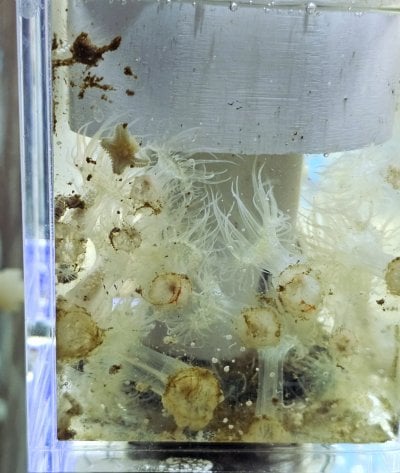This is the design for an internal coast to coast overflow I'm leaning towards installing in an old tank I'm working on restoring (just got it used from my LFS). Was hoping to get some sanity checking on the design before I pull the trigger on fabrication. The tank it's going in used to have corner overflows and an acrylic panel siliconed to the inside of the back glass. The back glass has a lot of etching on it, along with where the corner overflows were originally attached to the side glass panels, which I've been unable to remove.
The goals with this design was to hide all of the etching on the back and sides of the tank, and to convert the 2 original independent corner overflows into a single coast to coast style overflow that spans the back of the tank. The plan would be to use the (2) 1" bulkheads as the primary and secondary drains, and the (2) 3/4" bulkheads for the emergency drains in a bean animal overflow setup. The tank is 160 gallons, so I'm aiming to have 1600 - 2000 GPH of flow going through it.
Concerns:
- Is a 3/4" gap between the back glass and the overflow going to cause headaches down the road with cleaning issues?
- Can I achieve a 1600+ GPH flow rate through this setup?
- Is 1/4" acrylic thick enough for this? or should I go with 3/8" instead?
- Should this be installed at the same time I reseal the tank? or installed after the resealing has partially / fully cured?



If this is a bad design, then the alternative options are:
- Install new corner overflows and a back panel like the tank originally had
- Drill back of tank for an external overflow rated for 2000 GPH, and cover back glass inside with an acrylic panel. Side glass would likely still show etching
The goals with this design was to hide all of the etching on the back and sides of the tank, and to convert the 2 original independent corner overflows into a single coast to coast style overflow that spans the back of the tank. The plan would be to use the (2) 1" bulkheads as the primary and secondary drains, and the (2) 3/4" bulkheads for the emergency drains in a bean animal overflow setup. The tank is 160 gallons, so I'm aiming to have 1600 - 2000 GPH of flow going through it.
Concerns:
- Is a 3/4" gap between the back glass and the overflow going to cause headaches down the road with cleaning issues?
- Can I achieve a 1600+ GPH flow rate through this setup?
- Is 1/4" acrylic thick enough for this? or should I go with 3/8" instead?
- Should this be installed at the same time I reseal the tank? or installed after the resealing has partially / fully cured?
If this is a bad design, then the alternative options are:
- Install new corner overflows and a back panel like the tank originally had
- Drill back of tank for an external overflow rated for 2000 GPH, and cover back glass inside with an acrylic panel. Side glass would likely still show etching





















